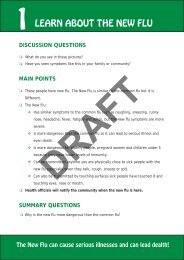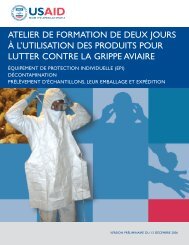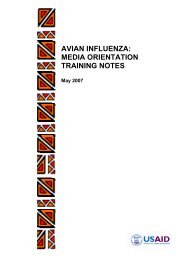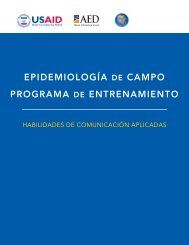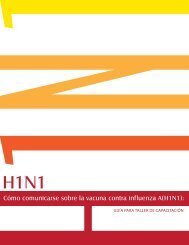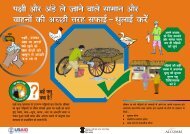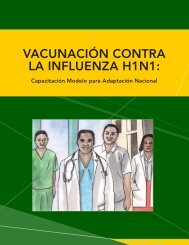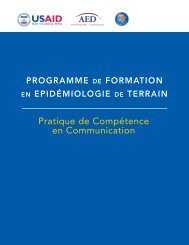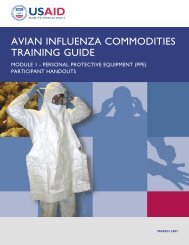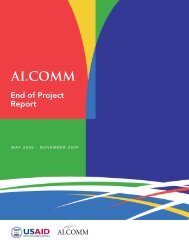English
English
English
- No tags were found...
You also want an ePaper? Increase the reach of your titles
YUMPU automatically turns print PDFs into web optimized ePapers that Google loves.
Baseline Knowledge Attitudes PracticesSurvey of Animal Health Workers onAvian and Human InfluenzaPrepared byNielsen VietnamforAvian Influenza Behavior Change Communication (AI BCC)Academy for Educational DevelopmentFunded byUnited States Agency for International DevelopmentAugust 19, 2009
Contents Context Methodology and Sample Design• Research Objectives• Sampling Techniques• Respondent Definition• How Did We Collect Data• Questionnaire Flow Detailed Findings
Context Methodology and Sample Design• Research Objectives• Sampling Techniques• Respondent Definition• How Did We Collect Data• Questionnaire Flow Detailed Findings
ContextUnder the Provincial Program on Avian and Human Influenza (AHI) funded by USAID,AED’s AI BCC project is implementing training, communication and research activitiesto improve understanding and practices of small commercial poultry farmers andanimal health workers regarding AHI in 2009. The provincial package covers Ha Namand Hung Yen in the north, Quang Tri in the center and Can Tho and Kien Giang in thesouth. AED is coordinating interventions with other USAID-partners i.e., FAO, WHO,Abt Associates.Majority of AED interventions at the commune level are in three provinces – Ha Nam,,Quang Tri and Kien Giang.Through a competitive bidding process, Nielsen Vietnam was awarded a contract byAED to conduct a Knowledge- Attitudes-Practices (KAP) Survey of Animal HealthWorkers and Small Commercial (sector 3) Poultry Farmers to serve as baseline tomonitor and assess training and other activities.This is the report on the Baseline Animal Health Worker survey
Business Needs Assessment Methodology and Sample Design• Research Objectives• Sampling Techniques• Respondent Definition• How Did We Collect Data• Questionnaire Flow Detailed Findings
Research Objectives : To gather information onKnowledge, understanding and beliefs of animal health workers on AI, itssymptoms, modes of transmission, preventive measures in poultry andactions to take when an AI outbreak occurs in farms and communitiesKnowledge, understanding and beliefs of animal health workers ontransmission of AI to humans specifically symptoms of human H5N1influenza and key preventive measuresPractices of animal health workers regarding prevention, control andreporting of AI occurrence in their areas of coverage, if outbreaks haveoccurred; if outbreaks have not occurred, what practices they are doingand plan to doKnowledge of animal health workers on what actions to take if householdmembers show symptoms of human H5N1 influenzaSources of information on the above matters and perceived credibility ofthose sources.
Research DesignSampling Techniques• Purposive Sampling• Geographic coverage: Ha Nam,Quang Tri, Kien Giang• Fieldwork: Ha Nam started on June 01and ended on June 10Quang Tri started on May24 and ended on June 02Kien Giang started on May24 and ended on June 05Respondent Criteria• Animal Health Worker(AHW) Licensed or nonlicensed Aware of AvianInfluenzaSample Size• Total sample size N=511• Ha Nam (N= 150 for AHW)• Quang Tri (N= 165 for AHW)• Kien Giang (N= 196 for AHW)
How Were Animal Health Workers Recruited? Overall, there are three levels of sampling for a sample design: Level 1"Random Sampling”; Level 2 "Quota Sampling - Fixed Route“ and Level 3"Quota Sampling - Open Route”.• In this study, we used Level 3 Purposive Random Sampling. Belowdescribes step by step how animal health workers were recruitedStep 1• At Provincial level,Group Leaders(GL) contacted thekey contact peopleof the VeterinaryDepartment of HaNam, Quang Triand Kien Giang.Here, anintroductory letterwas issued for GLto be used inDistrictsStep 2• At Districtlevel, GLwasprovidedwith the keycontactpeople ofCommunesStep 3• At Commune, interviewersare provided contactinformation of the animalhealth workers from headof villages.
Kim BngTX. Phñ LýThanh Liª mDuy Tiª nB×nh LôcLý Nh©nHa Nam Province Location: the south-west of the RedRiver delta Area: 850 square km Population: 837,662 Economy: mainly agriculture,forestry and aquaculture (making ofone third of total provincial GPP) Other useful facts in 2008:• Number of licensed veterinarians:57• Number of licensed animal healthworkers: 827No1234DistrictBinh Luc#*(n=30)Duy Tien#(n=30)Ly Nhan#(n=30)Kim Bang#(n=40)Studied CommunesDong Du*; Binh Nghia;Dinh Xa; Trang An; DinhNghia; Trinh XaDuy Minh*; Yen Bac; DuyHai;Hoang DongNhan My; Nhan Thinh; DucLy; Dao Ly; Dong Ly;Nguyen Ly; Cong LyThanh Son; Lien Son; KhaiPhong; Ba SaoThuy Loi; Ngoc Son; DongHoa; Thi Son; Kim Binh5ThanhLiem#(n=40)Kien Khe; Thanh Ha;Thanh Tuyen; Thanh Binh;Lien Thuan; Thanh luu;Thanh Thuy; Liem Can;Liem Kiet; Thanh Tan•# where fieldwork was conducted•* where there was AI outbreak
Quang Tri Province Location: North CentralVietnam Area: 4,760 square km Population: 625,800 Other useful facts in 2008:• Number of licensedveterinarians: 50• Number of licensedanimal health workers:543No1234DistrictGioLinh*#(n=45)TrieuPhong*#(n=30)VinhLinh#(n=30)Cam Lo#(n=30)Studied communesGio My*; Trung Son*; GioThanh*; Gio Phong; TrungHaiTrieu Trung*; Trieu Do;Trieu Trach; Trieu SonVinh Thuy; Vinh Hoa; VinhLong; Vinh SonCam Thanh; Cam Tuyen;Cam Hieu5Dong Ha#(n=30)Dong Luong6Hai Lang#(n=15)Hai Thanh; Hai Truong•# where fieldwork was conducted•* where there was AI outbreak
Phó QuècKiª n HiTX. Hµ Tiª nKiªn L- ¬ngHßn § ÊtAn MinhAn BiªnCh©u ThµnhT©n HiÖpVÜnh ThuËnGß QuaoGiång GiÒngTX.R¹ch Gi¸Kien Giang Province Location: Mekong delta ofSouthern Vietnam Area: 6299 square km Population: 1,634,043 Other useful facts in 2008:• Number of licensedveterinarians: 17• Number of licensedanimal health workers:370No12345DistrictGo Quao#*(n=30)Tan Hiep#*(n=30)An Bien#(n=30)Giong Gieng#(n=30)Chau Thanh#(n=35)Studied communesVinh Tuy*; Thoi Quan; Dinh Hoa; Dinh AnTan Hiep A*; Tan Thanh; Tan An;Tan Hoi; TanHiep B; Thanh Dong 3; Thanh TriHam Yen*; Dong Thai; Dong Yen; Hung Yen; AnBien; Thu 3 Town; Tay Yen; Tay Yen A; NamThai; Nam Thai ANgoc Truc; Giong Gieng Town; Long Thanh;Ngoc Thanh; Da Ban ThachMinh Luong; Mong Tho; Mong Tho B; Mong ThoA; Minh Hoa; Thanh L?c; Gi?c Tu?ng; Vinh HoàHi?p; Vinh Hoà Phu; Bình AnHon Dat#(n=23)Son Kien; Nam Thai Son; Binh Giang; Binh Son;Hon Dat Town; Lin Huynh; My Hiep son; My Lam;My Phuoc; My Thai; My Thuan; Son Binh; ThoSon; Soc Son Town6Kien Luong#(n=18)Duong Hoa; Kien Binh; Vinh Dieu; Vinh Phu;Kien Luong Town; Binh An; Binh Tri; Phu My;Hoa Dien; Phu Loi; Tan Khanh Hoa•# where fieldwork was conducted•* where there was AI outbreak
Questionnaire FlowScreening questions (Q2-Q5)Awareness Of Avian Influenza (Q6-Q7)Past Training On Avian Influenza (Q8-Q17)Knowledge Of Avian Influenza Among Poultry (Q18-Q22)Prevention And Control Of Avian Influenza Among Poultry (Q23-Q62)Knowledge of Avian Influenza To Humans (Q63-Q75)Sources of Avian Influenza Awareness (Q76ab)Media Habits (Q77-Q82ab)Demographics (Q83-Q88)32 OPEN ENDED QUESTIONS, 56 CLOSED ENDED QUESTIONS
Business Needs Assessment Methodology and Sample Design• Research Objectives• Sampling Techniques• Respondent Definition• How Did We Collect Data• Questionnaire Flow Detailed Findings
1.Avian Influenza Awareness
7 out of 10 AWH are males, 65% of them belong to class EF. Most of them are fromages 36 and above and have varied education levels. More than 80% have receivedAI training.Profile Of Animal Health WorkersAll Animal Health Workers (n=511)GenderMale72%AttendingAI trainingTrained86%Female28%None Trained14%25 and below9%Primary and Elementary school26%26-3523%High school24%Age36-4524%EducationDiploma/ Vocational training12%46 and above45%College34%AB0%Bachelor degree4%SECCD34%Raise PoultryRaising poultry63%EF65%Non-raising poultry37%
All AHWs are aware of Avian Influenza in overall and the top three knowledge of AIare related to “the transmission of AI”, “an infectious caused by H5N1 virus” and“cause fatal disease to humans”.Have you heard of Avian Influenza?All Animal Health Workers (n=511)Is transmissible to humansIs an infectious disease caused by H5N1 virus inthe airWhat do you know about AI?All Animal Health Workers (n=511)Cause fatal disease to humansA disease that can cause massive death45%39%56%100%YesHas strong spreadAvian flu is a very dangerous infectious diseaseamong poultryH5N1 disease is originated from poultryIs transmissible among poultryEasily cause a fatality to poultryEasily transmit to humans through respirationH5N1 causes a heavy damage to the economyHas no cure yet/can only vaccinations forprevention for this disease27%23%19%19%13%10%10%Source: Q6. Have you heard of Avian Influenza? (Close-end)Source: Q7. What you know about AI? (Open-end)
More than 80% of AHW have attended an AI training recently and the key organizeris Sub-DAH.Have you ever attended AItraining before?All Animal Health Workers (n=511)Who organized the AI training?All Animal Health Workers (n=511)Sub-DAH74%14%Vietnam Poultry Association15%86%Local vet centre4%Food and agricultureorganisation/FAO3%YesNoDepartment of animal health ofVietnam1%Vietnam Veterinary Association1%Source: Q8. if you ever attended a training about Avian Influenza before? (Close-end)Q11. Who organized the training? (Close-end)
78% say that the most recent AI training attended was about “prevention methods toH5N1” and the training was held 1-5 months ago.What were the training about?Those Who Attended AI Training (n=439)When did it happen?Those Who Attended AI Training (n=439)Prevention methods to H5N1Symptoms/ signs/ ways to recognize H5N1 amongpoultry25%78%1 monthago35%Vaccination skills/ knowledge14%Communication about the Avian Flu awareness10%2-5monthsago26%Consequences/impacts of the disease9%Causes of the disease7%Skills to deal with the areas with H5N1 outbreaksCommunicate local community that H5N1 is adangerous virus7%6%6-12monthsago16%Source: Q12. What was the training about? (Open-end)Source: Q9. When was the last time attending the most recent AI training? (Close-end)
Only 29%of AHW attended another AI training and Sub-DAH is also the keyorganizer for this training.Aside from the most recent AI training, didyou attend any other AI training?All Animal Health Workers (n=511)Who are the organizers?Who Said Attended Another AI Training (n=129)Sub-DAH79%Vietnam PoultryAssociation9%71%29%Women union ofprovince/district3%Local vet centre3%Association oflocal farmers2%YesNoAgriculturalextensioncentre2%Source: Q13. Aside from the most recent AI training, did you attend any other training on AI? (Close-end)Source: Q16. Who organized this training? (Close-end)
The contents of the other AI training AHWs attended focus on prevention andsymptoms and the training was conducted over one year ago.What was the training about?Those Who Attended Another AI Training (n=129)When did it happen?Those Who Attended Another AI Training (n=129)Prevention methods to H5N172%Trainings on symptoms/signs/ways to recognize H5N1among poultry22%1 monthago7%Vaccination skills/knowledge15%Skills to deal with the areas with H5N1 outbreaksCommunicate local community that H5N1 is a dangerousvirus9%8%2-5monthsago22%Ways to clean breeding facilitiesConsequences/impacts of the disease8%7%6-12monthsago24%Ways to raise poultry5%Communication about the Avian Flu awareness4%Over 1year47%Disinfection methods4%Source: Q17. What was the training about (Open-end)Source: Q14. When did it happen (Close-end)
2. Knowledge of Avian Influenza amongPoultry
Overall, most of AHW know all birds can get AI. Key reasons for poultry to get AIare related to “birds’ migration” and “transporting” poultry from place to place.Which birds can get AI?All Animal Health Workers (n=511)What cause poultry to get AI?All Animal Health Workers (n=511)All birds85%Birds' migration can transmit the disease to other poultryTransport the poultry from the infected place to this place41%21%Chickens15%Do not clean the breeding facilities often or clean enoughPoultry drink water that carries the disease13%12%Ducks15%Unexpected change in weatherPoultry do not have vaccinationsDue to the unclean raising environment12%8%8%Geese5%Let poultry run free in fieldsEat foods that carry the disease7%6%TurkeyWild bird5%2%Contact other sick poultryThrough the feces/respiration of birdsWet condition/place make the poultry weak hence thedisease easily attracksBuy a sick breeding poultryBuy uncertified/unknown poultry6%5%5%4%4%Local people throw dead poultry negligently4%Source: Q18. Which birds can get AI (Close-end)Source: Q19 What cause poultry/bird to get AI (Open-end)
Symptoms recognized in Chicken and Ducks are similar. Very few AHWs mentioned“sudden massive death” as one of the common symptoms of AI.What are the symptoms thatshow CHICKEN get AI?All Animal Health Workers (n=511)What are the symptoms thatshow DUCK get AI?All Animal Health Workers (n=511)Sluggish/sick chicken59%Sluggish/sick chicken51%Crest/skin/mouth/tongue becomes black andblue49%Suffers from in appetence26%Suffers from in appetence30%Feather is ruffled up/lost21%Redden the skin areas without hair/at legsSalivates at mouth/nose29%28%Redden the skin areas without hair/at legsMass death among poultryConvulsive/go around20%18%17%Feather is ruffled up/lost26%Salivates at mouth/nose14%Feces are white/green/light red/liquid20%Lose balance in movement14%Mass death among poultry15%Feces are white/green/light red/liquid14%High fever15%High fever12%Source: Q20/Q21 Sign/symptom on duck/chicken that have got AI (Open-end)
80% of AHWs say ducks can be infected without showing any symptoms.Can ducks be infected with AI even withoutshowing any symptoms?All Animal Health Workers (n=511)20%80%YesNoSource: Q22 Can ducks be infected with AI even without showing any symptoms (Close-end)
3. Prevention and Control ofAvian Influenzaamong Poultry
Majority AHWs consider AI is very serious. Key reasons for considering AI veryserious/serious is related to “fatality and incurability of H5N1”.How serious the AI is?All Animal Health Workers (n=511)Why do you think AI is serious?All Animal Health Workers (n=507)Fatal disease to humans/Quick death amonghumans if do not have timely cureIs transmissible to humans52%70%6%1%Heavy damages to the economy44%Cause massive death among poultrySpeedy transmission25%20%93%Very serious (5.0) Serious (4.0)Neutral (3.0) Not serious (2.0)Not very serious (1.0)Affect the public healthNot cure for humans yetIt is an infectious virusCause death among poultryWide spreadCause disease among poultryTransmit to other animals6%5%5%4%3%3%2%Source: Q23 How serious is avian influenza (Close-end)Source: Q24 Why do you think AI is serious (Open-end)
According to AHW, actions which are farmers can take to prevent AI in poultryare Vaccination, Regular Cleaning and Disinfection.What can be done by farmers to prevent AI from occurring in poultry?All Animal Health Workers (n=511)Timely/periodic vaccinationClean the breeding facilities regularly67%59%Disinfect the breeding facilitiesSpray lime around the breeding cage/holes for burying deadpoultryDo not allow poultry run freelyKeep flocks separately/separate sick poultry from the flockRaise certified and known poultry/assured breedWear glove, mask, protection clothes when contactingpoultryProtect the cage carefully/closed cage/open cage with fenceDo not allow people to contact dead/sick poultryDo not prepare/eat sick/dead poultryReport to animal health centre9%9%6%6%5%4%3%2%2%34%Source: Q25 What can be done by farmers to prevent AIfrom occurring in poultry (Open-end)
According to AHWs, if farmers find sick poultry in their farm, the first thing farmersshould do is “report to the nearest vet” (74%) then “keep flock separately from the sickpoultry (51%).What should be done by farmers if they find sick poultry in their farm?All Animal Health Workers (n=511)Report to the nearest vet74%Keep flocks separately/separate sick poultryfrom the flockReport to a local authority24%51%Disinfect the breeding facilitiesDo not prepare/eat sick/dead poultryTimely/periodic vaccinationDo not transport, sell, buy sick poultryStrictly monitor flocks of poultry to preventdisease in timeDo not allow people to contact dead/sick poultryClean the breeding facilities regularlySpray lime around the breeding cage/holes for buryingdead poultryDestroy immediately after the poultry is dead7%5%5%4%4%3%3%2%2%Source: Q26. What should be done by farmers if they find sick poultry in their farms(Open-end)
AHWs say that farmers should “Report to the nearest vet” (69%) if they find deadpoultry in their farm followed by “Bury dead poultry…” (37%).What should be done by farmers if they find dead poultry intheir farm?All Animal Health Workers (n=511)Report to the nearest vet69%Bury dead poultry/put the dead poultry into a nylon pack and bury it deeplyDestroy immediately after the poultry is deadReport to a local authorityDisinfect the breeding facilitiesSpray lime around the breeding cage/holes for burying dead poultryKeep flocks separately/separate sick poultry from the flockDo not allow people to contact dead/sick poultryDo not transport, sell, buy sick poultryDo not prepare/eat sick/dead poultryClean the breeding facilities regularlyDo not throw the dead poultry negligently37%26%23%19%14%11%7%7%6%5%4%Source: Q27. What should be done by farmers if they find dead poultry in their farms (Open-end)
When receiving a report of sick poultry from a farmer, the first action AHWs will do is“Come to identify the reason causing the death of the poultry” (63%).What should AHW do if they receive a report of sick poultry from farmer?All Animal Health Workers (n=511)Come to identify the reason causing the sick of the poultry and if it is caused by H5N1Separate the sick poultry from the flock/Communicate people not to let their poultry tocontact with the infected poultryReport to animal health centreQuickly come to the place reported with the H5N1 outbreakReport to everyone about the place with the outbreak and localize that placeTest the sample to check if there is H5N1 or notKeep track of each poultry to give medicineDirectly spray chemicals to disinfect the farm with other peopleFollow guidelineReport to local governmentBurn the dead poultry (put into the nylon pack)Report to superior/specialized organizations28%18%18%15%12%10%9%8%7%5%5%63%Source: Q28. What should you, as an animal health worker, do if you receivea report of sick birds from a farmer (Open-end)
If AHW receives a report of dead poultry from a farmer, AHWs will “Burn the dead poultry”(39%) and/or “Come to identify the reason causing death of poultry” (37%).What should AHW do if they receive a report of dead poultryfrom farmer?All Animal Health Workers (n=511)Burn the dead poultry (put into the nylon pack)Come to identify the reason causing the death of the poultry and if it is caused by H5N1Dig holes to bury poultry/ dig hole to bury poultry placed in a nylon packReport to animal health centreTest the sample to check if there is H5N1 or notQuickly come to the place reported with the H5N1 outbreakReport to everyone about the place with the outbreak and localize that placeDirectly spray chemicals to disinfect the farm with other peopleDistribute the lime around the cage/ buried holeFollow guidelineReport to local governmentSeparate the sick poultry from the flock/Communicate people not to let their poultry tocontact with the infected poultry39%37%25%20%19%17%15%14%13%13%10%9%Source Q29. What should you, as an animal health worker do if youreceive a report of dead birds from a farmer (Open-end)
Majority of AHWs think an AI outbreak will not likely happen in their commune becausepoultry are vaccinated. The minority who say AI will likely happen cite the habit ofletting poultry run freely, migration and not having proper vaccination as reasons.How likely do you think that there will bean AI outbreak in your commune?All Animal Health Workers (n=511)Very likely not happen (1.0)Likely not happen (2.0)Slightly not happen (3.0)Neutral (4.0)11%35%17%Reasons AIUnlikely tohappen(n=481)•Follow full vaccination: 50%•Always prevent strictly: 14%•Local people here have a good awareness ofAvian Flu: 9%•People keep their breeding facilities cleaned:9%•People carry out properly the communicationactivities: 6%Slightly happen (5.0)6%2%Likely happen (6.0)Very likely happen (7.0)25%4%Reasons AIlikely tohappen(n=158)•Raising habit to let poultry run freely: 6%•Can not control the number of birds migratedfrom other places: 5%•Poultry does not have proper vaccination: 5%Total(n=511)Q31 (Close-end)Q32: Open-ended
All AHWs say they are doing something to prevent poultry in their area from gettingAI. Communicating to people to continue full vaccination is the main action (72%)followed by telling people not to neglect cleaning of breeding facilities (34%).As an AHW, are you doing anything toprevent poultry not getting H5N1 inyour areas?All Animal Health Workers (n=511)Q33Yes100%0%NoWhat are you doing?All Animal Health Workers (n=511)Communicate people to continue vaccinations 100%Do not neglect with the cleaning of breeding facilitiesFollow guidelineCommunicate people to buy breeding animal with theclear origin and quarantinedDirectly spray chemicals to disinfect the farm with otherpeopleInstruct people about the methods to prevent H5N1Communicate people to not transport, sell sick poultryRequest people to wear glove, mask, protection clotheswhen contacting poultryCommunicate people to be aware of the danger of theepidemic diseaseDo not slaughter/eat sick/dead poultryCommunicate people to wash their hands with clean waterand soap before and after contacting poultryDistribute the lime around the cage/ buried hole5%4%4%4%3%3%15%13%13%11%34%72%Source: Q34. What are you doing to prevent poultry in your areas fromgetting avian influenza even if there is no outbreak (Open-end)
Other actions by AHWs to prevent poultry in their area are related to hygiene andcommunication like washing hands with soap and water.Apart from that, what else are you doing?All Animal Health Workers (n=511)Wash hand with clean water and soap BEFORE AND AFTER contacting with poultryCommunicate farmers/others not buy or sell poultry that has been sick or deadCommunicate to farmers to only buy breeders from certified or known sourcesCommunicate farmers/others to keep poultry in a protected environment (enclosedbuilding/ fenced area)Immediately report of sick or dead poultry to veterinary officials and local authoritiesCommunicate farmers/others avoid contacting with sick and dead poultryCommunicate to farmers to wear mask and gloves when handling poultryCommunicate farmers/others to keep all poultry brought to the farm separate from otherpoultry for at least 2 weeksCommunicate to farmers to clean and disinfect their farm regularlyCommunicate farmers/others to control entries into the farm (do not let middleman enterthe farmyard, keep visitors away from poultry etcCommunicate farmers/others to vaccinate poultry against AI71%70%67%66%63%61%59%58%54%54%40%Source: Q35. Apart from that, what else are you doing to prevent poultry in youcommune from getting AI H5N1 even if there is no outbreak (Close-end)
All AHWS report they are doing something to inform farmers in their area on whatto do if there is an AI outbreak. 25% of AHWs say that they request farmers toreport immediately to vet centre when they have an AI outbreak in poultry.Are you doing anything toinform farmers on what to do ifthere is AI outbreak?All Animal Health Workers (n=511)What are you doing?All Animal Health Worker (n=511)Request farmer to report veterinary centers immediatelywhen finding out H5N1 among their poultryRequest farmer use PPE when contacting poultry25%22%100%YesCommunicate people to keep their breeding facilities cleanAdvise them not to eat/slaughter sick/dead poultryCommunicate people not to transport chicken/ducks to thearea with the H5N1 outbreakLimit contacting sick/dead poultry (including children)Regularly spray disinfections chemicalsBefore and after contacting poultry, wash hands with cleanwater/soapGuide/directly meet people to guide people about H5N1preventionCommunicate farmer to disinfect their farmThrough a loud speaker of the communeTemporarily keep the poultry separately during the outbreak18%14%12%11%9%9%8%7%6%6%Source: Q36. Are you doing anything to inform farmers in yourarea on what to do if there is an AI outbreak (Close-end)Source: Q37. As an animal health worker, what are you doing to informfarmers on what to do if there is an AI H5N1 outbreak (Open-end)
Other actions by AHWs are mostly communication activities as described as below.Apart from that, what else are you doing if there is an outbreak?All Animal Health Workers (n=511)Communicate to farmers to wash hands with clean water and soapbefore and after contacting with poultryCommunicate with farmers to immediately report sick or dead poultryto vet or village headCommunicate with farmers not to transport any poultry from outbreakareaCommunicate with farmers to use mask and gloves when handling anypoultryCommunicate farmers/others avoid contacting with sick and deadpoultryCommunicate with farmers not to eat sick or dead poultryCommunicate farmers/others that if people had contact with poultryand have fever to immediately go to their local health center or hospitalCommunicate farmers/others not buy or sell poultry that has been sickor deadCommunicate with farmers to clean and disinfecttheir farmCommunicate farmers/others eat only thoroughlycooked poultry and poultry products (no pink meator runny eggs)Communicate farmers/others to control entries into the farm (do not letmiddleman enter the farmyard, keep visitors away from poultry etc75%72%70%66%62%60%59%57%57%57%50%Source: Q38. Apart from that, what else are you doing to inform farmers onwhat to do if there is an AI outbreak (Close-end)
Almost all AHWs claim to give vaccination to poultry in their area. Most AHW gavevaccination within last month.Have you given vaccination topoultry in your area?All Animal Health Workers (n=511)When was the last time you gavevaccinations?Those who gave vaccinations (n=506)Last week14%1%Last twoweek23%99%Last threeweek16%Last month15%YesNoBefore lastmonth27%Source: Q40. Have you given vaccinations topoultry in your area (Close-end)Source: Q41. When was the last time you gave vaccinations (Close-end)
93% AHW say ducks require 2 vaccinations. 77% AHW say 28-30 days is the days apartthe first and second vaccination. Most of AHW claim giving vaccination to ducks from15 days or older.How many vaccinations do DUCKrequire?All Animal Health Workers (n=511)How many days apart should the firstand second vaccination be given?Those who ans Code 2 to 3 in Q43 (n=502)1-14days4%5%2%15-27days15%28-30days77%93%Over 30days5%First Vaccination To DucksAll Animal Health Workers (n=511)One Two More than twoQ43. How many vaccinations do ducksrequire (Close-end)•1-14 days: 4%•15-27: 15%•28-30 days: 77%•Over 30 days: 5%Source: Q44. How many days apart should the first and second vaccinations begiven (Close-end)Source: Q45. When should the first vaccination for ducks be given (Close-end)
84% of AHWS say that vaccination is not harmful to young ducks. Of the 16%AHWS who say that vaccination is harmful to young ducks, 53% claim that youngducks can get side effects from vaccinations.Is vaccination harmful toyoung duck?All Animal Health Workers (n=511)Why do you think vaccination harmfulto your duck?Those who ans Code 2 to 3 in Q43 (n=83)Young duck can get side effect from vaccination such as light fever,quit eating53%Immune system of young ducks is weak and vaccination is stronghence this can cause fatal harm to young duck20%84%16%Vaccination for weak young duck will only weaken them13%Cause the duck grow slowly12%Cause slow growth in the young ducks' feather11%YesNoSome young ducks can not stand the chemicals in the vaccination8%Affect the wings of the ducks1%Q46. Is vaccination harmful to young ducks (Close-end) Source: Q47. Why do you think that vaccination harmful to young ducks (Open-end)
Nearly all AHWs say they wear something when handling poultry. 97% say theywear mask and gloves when handling poultry. Of those who wear mask and gloves,65% say they wear them always.Do you wear anything to protect yourselfwhen handling with poultry?All Animal Health Workers (n=511)What do you wear?Those who claimed to wear (n=507)Mask 3%1%Glove andMask97%99%How frequently do you wear Glove &Mask?Those who claimed to wear Glove & Mask (n=493)YesNoAlways65%Often34%Sometimes1%Q48. do you wear anything to protect yourself whenhandling poultry (Close-end)Q49. What do you wear (Close-end)Q50R3. How often do you wear-Mask and gloves (Close-end)
All AHWs say they wash hands with soap and clean water when handling poultry. 61%of AHWS report that they always wash before and after handling poultry while 21% saythey always wash after handling poultry.Do you wash your hands with soap andwater when handling poultry?All Animal Health Workers (n=511)How often do you wash your hands?All Animal Health Workers (n=511)Always before and after handling poultry61%Always after handling poultry21%100%Often before and after handling poultry8%Often after handling poultry6%YesNoSometimes before and after handling poultry1%Always before handling poultry1%Sometimes after handling poultry1%Q51. As an animal health worker, do you wash your handswith soap and water when handling poultry (Close-end)Source Q52. How often do you wash your hands with soapand water when handling poultry (Close-end)
87% of AHWs who always wash hands before and after handling poultry say thereason is to prevent transmitting disease to poultry. 63% AHWs report changingclothes frequently after handling poultry.Why do you wash your hands?Those who claimed always wash hands (n=312)How Often Do You Change YourClothes After Handling Poultry?All Animal Health Workers (n=511)Prevent transmitting germs topoultry/Prevent transmitting the diseasefrom poultry87%Every time14%Protect myself30%Frequently63%Kill germs12%Sometimes13%I also have germs on my hands beforecontacting poultry2%Rarely9%Avoid feeling of dirt1%Never1%Source: Q53R1. Why do you wash your hands with soapand water when handling poultry (Open-end)Source Q54. How often do you change your clothes afterhandling poultry (Close-end)
82% of AHWs say they do something before entering a farm. Of these, 80% reportwashing hands with soap and water, 52% report washing shoes or slippers with soapand water.Did you do anything before enteringfarmer’s poultry?All Animal Health Workers (n=511)What did you do before entering apoultry farm?Those Who Did Some AI Preventions (Code 1 In Q55)18%Wash hands with soap and water beforeentering farm80%82%Wash shoes or slippers with soap andwater before entering farm52%YesNoWash bicycle or motorbike tires beforeentering farm17%Source: Q55. Before entering someone's poultry farmer, doyou do anything to ensure that the poultry in the farm areprotected from AI virus from outside (Close-end)Source Q56. What do you do before you enter apoultry farm (Close-end)
34% claim to know what is a PPE (Thiết Bị Bảo Hộ Cá Nhân). Of these, 75% say that PPEis mask and/or gloves.Do you know what a “PPE” is?All Animal Health Workers (n=511)What is PPE?Those Who Were Aware Of PPE (n=173)Mask75%66%34%GloveBoot/shoe75%48%Protective clothes34%Hat19%Glass18%YesNoIs a tool to protecthumans infected12%Raincoat8%Blue Shirt8%Source: Q57. Do you know what a “PersonalProtective Equipment” (PPE) is (Close-end)Source: Q58. What is PPE (Open-end)
85% of those who know PPEs say it is easy to access. Dong Ha vet centre and subvet department are two key places to access PPE. 85% of those received trainingon PPE.Where To Easily Access PPEThose Who Ans Easily Access PPE (n=147)Do you access to a PPE easily?Those Who Were Aware Of PPE (n=173)Dong Ha veterinary centerSub veterinary department31%20%15%Animal health worker comes to distributeDistrict/commune people committee17%10%Buy from the local market9%Local medical centre8%85%YesNoHave you been trained on how to usePPE?Those Who Ans Easily Access PPE (n=147)15%Source: Q59. Do you have easy access to a PPE? (Close-end)Source: Q60. Where can you easily get one? (Open-end)Source: Q61. Have you been trained on how to put it on and use a PPE? (Close-end)Yes85%No
4. Avian Influenza Prevention and ControlAmong Humans
85% of AHWs say they can recognize signs of AI in humans. Causes for humans to getAI are eating sick poultry and contact with infected poultry. 92% of AHWs say high feveris the key symptom of a human with AI.What cause human to get AI?Those Who Were Aware Of AI (n=433)Eat sick poultry52%Can you always realize whenhuman get AI?All Animal Health Workers (n=511)Transmits H5N1 to humans when contacting poultryDo not wear PPE when contacting poultry38%35%14%1%Eat unwell-cooked poultryThrough respiration when contacting sick poultry6%15%Q63. Open-ended85%What are sign and symptom of AIamong human?Those Who Were Aware Of AI (n=433)Yes No DKHigh feverDifficult breathing55%92%Cough36%Stiff breast27%Tired25%Source: Q62. Can you always realize when humans get AI (Close-end)Headache/lose balance21%Q64. Open-ended
91% of AHWS say that if they think someone has AI, the person should be broughtimmediately to health center.What should you do if you think someone get AI?All Animal Health Workers (n=511)Bring immediately to health center91%Inform community health worker58%Bring immediately to doctor/Hospital53%Keep patients separated3%Get medicine from pharmacy/medicine shop3%Source: Q65a,b. If you think someone has AI, whatshould you do ? (Close-end)
24% of AHWS report having had an AI outbreak in their commune; of these, 86% saythat the outbreak happened in the commune more than a year ago.Have there been any outbreak of AIin this commune?All Animal Health Workers (n=511)How long did it happen?Those who said yes (n=120)1%2-6 months ago8%75%24%6 months to 1 year6%Yes No DKMore than one year ago86%Source: Q66a,b. Have there been any outbreak of AI inthis commune? (Close-end)Source: Q67b. How long did that happen in your commune(Close-end)
12% of AHWs report having had an AI outbreak in their village; of these, 95% say theoutbreak happened in the village more than a year ago.Have there been any outbreak of AIin this village?All Animal Health Workers (n=511)How long did it happen?Those who said yes (n=60)12%2-6 months ago2%88%6 months to 1 year3%More than one year ago95%YesNoSource: Q66a,b. Have there been any outbreak of AI inthis village? (Close-end)Source: Q67a. How long did that happen in your village(Close-end)
16% of AHWs say they face some difficulties which prevent them from doing theirwork effectively. Of these, 52% say the difficulty is low awareness of local peopleresulting in non-cooperation in vaccination while 21% say “little allowance”.Do you confront any problem that preventyou from doing your work effectively?All Animal Health Workers (n=511)What are the problems?Those Who Said Yes (n=84)Low awareness from the local people hence they do not cooperatein vaccination as they are afraid that vaccination hasnegative impact on their poultry52%84%16%Little allowanceRoads to farms are quite far and not good conditions21%12%They are not aware of the consequence of the epidemic disease10%YesNoVaccination to wild ducks is very hard8%People do not report sick flock of poultry because they are afraidthat their poultry will be culled7%Source: Q68. As AHW, do you confront any problems thatprevent you from doing your work effectively? (Close-end)Source: Q69. what are these problems? (Open-end)
AHWS recommend actions to solve these problems as below :What should be done?Those Who Said Yes (n=84)Explain and communicate with the farmers about the danger of the epidemic disease for the community39%Request for more allowance to assist communicationCommunicate people that vaccination is not harmful to poultryProvide the transport (e.g. boats, etc)Communicate people through trainingTry to persuade by my wordsRequest superior to handle casesNeed the support from local governmentPersuade people about the importance of vaccination in prevention of the epidemic diseaseImprove the road conditions for easier commutingTraining on epidemiologyTraining on how to handle when there is AI outbreak23%11%7%6%6%6%6%5%5%2%2%Source: Q70. What do you think can be done to help in solvingthese problems? (Open-end)
Of things which will help them in improving their work, AHWs cite training onepidemiology (55%), regular meetings with vet (50%), training on culling andoutbreak response (50%), among others.What should be done to help you improving your work onAI prevention?All Animal Health Workers (n=511)Training on epidemiologyRegular meetings with vetTraining on culling and outbreak responseStudy visitsTraining on communicationTraining on surveillanceCommunication materials like poster/leafletRegular meetings with other animal healthworkersSupervision from vetUniform/badge/ID55%50%50%45%43%42%39%32%25%21%Source: Q71. As AHW, what will help you in improving yourwork on ai prevention and control? (Close-end)
76% of AHWs report using visual aids in their work. Aids include vaccination flyers(74%), leaflets (70%) and duck leaflets (69%). All AHWS find them useful in their AIcommunication. Many AHWs were able to show these materials.Are you using visual aids for AIcommunicating?All Animal Health Workers (n=511)What are the materials?Those Who Said Yes (n=387)Vaccination flyer74%24%AI prevention leafletDuck leaflet70%69%76%HatBagDuck vaccination poster34%27%41%YesNoQ72. (Close-end)Do you find these materials useful?Those Who Said Yes (n=387)Boots5%Can I see these materials?Those Who Said Yes (n=387)Q73a (Close-end)100%Duck leafletVaccination flyerAI prevention leafletHatBag51%43%39%27%24%Q74. (Close-end)YesDuck vaccination posterRaincoat11%4%Q73b (Close-end)
Key sources of AI information for AHWs are television (99%), followed by vet and AItraining (73%), loudspeaker (67%), radio (61%). AHWS think television is the mostreliable source of AI information followed by AI training.Where did you get AI information?All Animal Health Workers (n=511)TelevisionVetAI training that I attendedLoudspeakerRadioNewspaper/magazineNeighbor61%53%50%73%73%67%99%Which source do you consider your mostreliable source?All Animal Health Workers (n=511)TelevisionAI training that I attendedDept of Animal Health (DAH) or Ministry ofAgriculture and Rural Development (MARD)Vet11%8%27%49%People CommitteeLeaflets48%46%People Committee2%Friends/relatives45%Radio1%Dept of Animal Health (DAH) or Ministry ofAgriculture and Rural Development (MARD)Billboards/posters41%27%Leaflets1%Agricultural extension worker24%Loudspeaker1%Q76a. Open-endedSource: Q76B. Which one do you consider your single mostreliable source of information on AI? (Close-end)
5. Media Habits
AHW watched TV 1-3 hours a day, whilst they listened to the radio rarely, readnewspaper one or two times a week and rarely read magazine.How frequently do you read Magazine?All Animal Health Workers (n=511)How frequently do you watch TV?All Animal Health Workers (n=511)Everyday2More than 4 hours/day14One or two times/week53 - 4 hours/day23One to two times/month202 - 3 hours/day32Rarely601 -2 hours/day30Never12Less than 1 hour/day1How frequently do you read Newspaper?All Animal Health Workers (n=511)How frequently do you listen to Radio?All Animal Health Workers (n=511)More than 3 times/day17Everyday16One or two times/week45One or two times/week26Rarely37Rarely41Never2Never17Source: Q77/Q78/Q79/Q81.
VTV3 and VTV1 are the most often TV channels whilst FM is the most often radiochannel.Most Often Radio ChannelThose who listen to radio (n=422)Most Often Tivi ChannelAll Animal Health Worker (n=511)Radio station of VN FMRadio station of VN AMRadio station of HCM peopleKien Giang radio station225561VTV 3VTV 1Kien Giang TVQuang Tri TV4526184Ha Nam radio station3VTV 23Can Tho radio station3Can Tho TV (HCMC/CT)2Occasional Radio ChannelThose who listen to radio (n=422)Occasional Tivi ChannelAll Animal Health Worker (n=511)Radio station of VN FM53VTV 360Radio station of VN AM30VTV 154Ha Noi radio station19Kien Giang TV51Can Tho radio station16Quang Tri TV28Ha Nam radio stationRadio station of HCM people1410VTV 2Can Tho TV (HCMC/CT)2724Source: Q80/Q82.
Thank You



